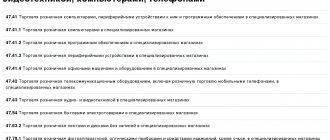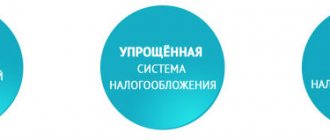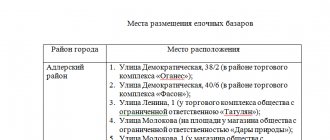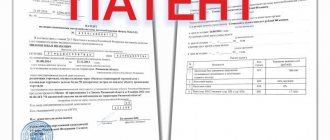Wholesale and retail trade
Trade is directly related to the purchase and sale of goods (Article 2 of the Federal Law of December 28, 2009 No. 381-FZ). Products are assets that a company originally purchased for resale rather than producing itself.
Accounting for goods is regulated by PBU 5/01. From this PBU we can conclude that the cost of goods includes the purchase price, transportation costs, customs duties, and more. Even interest on loans issued for the purchase of goods can reasonably be included in the cost price.
Companies can trade wholesale and retail. The difference between retail and wholesale trade lies in the volume of goods sold.
At retail, goods are sold in small quantities or individually to satisfy the personal needs of the buyer, while wholesale involves trading in large quantities of goods.
In addition, in retail trade, a transaction is made between a company and an individual, and in wholesale trade, goods are most often sold to a legal entity or individual entrepreneur.
Create receipt orders automatically, not manually! Connect Kontur.Market and Kontur.Accounting. The services are integrated and it will be easier for you to calculate taxes, maintain an income book and maintain cash discipline.
More details
Features of accounting in trade
Accounting in trade is about correctly executed documents and transactions drawn up on their basis.
Goods for resale are accounted for in account 41. The account has several subaccounts. The most commonly used account is 41.4 “Purchased Items”.
Goods are accounted for by name, quantity, storage location and financially responsible persons.
The cost of a product is its acquisition price, delivery costs, duties, agency fees, etc. (clause 6 of PBU 5/01).
for finished products. This account cannot be used in trading. Here you will need account 41 “Goods”. Sub-accounts are opened for this account. The purchase of goods is reflected by posting Debit 41 Credit 60. If necessary, VAT is allocated as a separate posting.
The sale of goods includes three entries: Debit 62 Credit 90 - revenue Debit 90 Credit 68 - VAT Debit 90 Credit 41 - cost
Let's analyze the differences between accounting in trade for wholesale and retail sales.
Which tax system to choose for LLC
An enterprise can choose which wholesale taxes to pay from only two modes:
- OSNO - general taxation system.
- simplified taxation system - simplified taxation system.
Although, in general, wholesale and retail trade and taxes are represented by the following options:
- PSN - patent taxation system.
- UTII - a single tax on imputed income.
OSNO is a universal regime that is applied in all areas of business and does not have any restrictions on the area of the premises, the number of employees and the amount of working capital. As for the simplified tax system, its use in some cases is impossible. Both modes require a cash register.
We invite you to familiarize yourself with: A grant from the USN Innovation Promotion Fund is income || Taxation of grants under the established system
In this case, expenses mean not only the input cost of the goods, but also other expenses associated with running a business. The full list of expenses allowed for accounting is regulated by Article 346.16 of the Tax Code of the Russian Federation. CONCLUSIONS:
- In regions that use UTII, for retail stores with a sales floor area of LESS than 150 sq. m. A tax system based on a patent can be a consolation for UTII, unless the legislator comes up with another alternative.
- In all other cases, as well as in Moscow (always), when registering an enterprise, it is advisable to write an application to apply the simplified taxation system (USNO).
1. Type of activity. Under the basic OSNO tax regime, you can conduct business in any direction. If we talk about special preferential regimes (STS, UTII, Unified Agricultural Tax), then the widest selection of activities exists on the simplified tax system. Within this regime, you can engage in production, wholesale and retail trade, and services.
The choice for UTII is much more modest: retail trade in areas of no more than 150 sq. m. and some services. The list of types of activities permitted for imputation is specified in Article 346.26 of the Tax Code of the Russian Federation, but this limited list can also be reduced by regional law, up to the complete abolition of ETNI in a certain territory. For example, in Moscow this regime is not used at all.
Well, as for the Unified Agricultural Tax, only fishery organizations and agricultural producers can switch to it, and the share of income from the sale of such products or catch must exceed 70% of total revenue. Organizations that are engaged only in the processing of agricultural products or catch are not entitled to apply the Unified Agricultural Tax.
2.Number of employees. In the simplified tax system and UTII regimes, the average number of employees cannot be more than 100 people. Restrictions on employees for the Unified Agricultural Tax exist only for fishing organizations and individual entrepreneurs paying agricultural tax: no more than 300 people. A significant portion of newly created organizations easily fit into this limit, so most LLCs with employees can apply preferential treatment. In the future, if the staff increases, it is necessary to switch to OSNO.
3. The need to work with VAT. This is a difficult tax to administer; you can find out more in the article “VAT: the most special and complex tax.” If you assume that your main customers will be large enterprises that will need to receive a refund of VAT paid, then you will have to work for OSNO. It is worth choosing a general taxation system for LLCs even if you independently import goods into the territory of the Russian Federation.
4.Regularity of activities and income generation. Of the taxation systems considered for LLCs, three (OSNO, USN, Unified Agricultural Tax) meet the condition: we pay LLC taxes only if real income is received. On UTII the situation is different; taxable income is a conditional amount calculated by the state. If this calculated imputed income is less than the real one, then the taxpayer wins, but if the income received is less than calculated by the formula, then the organization bears an excessive tax burden.
5.Expected annual income. Of all taxation systems for LLCs, the limit on income received per year is set only for the simplified tax system - in 2019 it is 150 million rubles.
Accounting in wholesale trade
All transactions with goods are reflected by postings.
Receipt (purchase) of goods
Debit 41 Credit 60 - goods were purchased from the supplier.
Debit 19 Credit 60 - VAT allocated.
Debit 41 Credit 60 - reflected other costs that increase the cost of purchased goods.
Selling goods
Debit 62 Credit 90 - showed the proceeds from the sale of goods to the buyer.
Debit 90 Credit 68 - VAT was charged on the sale.
Debit 90 Credit 41 - the cost of goods was written off.
Internal movement
Debit 41 Credit 41 - goods were transported from one warehouse of the organization to another. The analytics reflects the corresponding warehouses or materially responsible person (MRP).
Marriage
Debit 94 Credit 41 - defective goods were found in the warehouse.
Debit 44 Credit 94 - the loss of goods was written off within the limits of natural loss.
Debit 91 Credit 94 - losses in excess of natural loss were written off.
Debit 73 Credit 94 - losses due to marriage were attributed to the guilty party.
Accounting in retail trade
Accounting in retail can be carried out in two ways: the first method is similar to accounting for goods in wholesale trade, and with the second method of accounting, you need to use account 42 “Trade margin”. Let's consider transactions using account 42.
Receipt (purchase) of goods
Debit 41 Credit 60 - purchased goods from a supplier.
Debit 19 Credit 60 - VAT allocated.
Debit 41 Credit 60 - reflected other costs that increase the cost of purchased goods.
Debit 41 Credit 42 - showed the trade margin.
Selling goods
Debit 50 (62) Credit 90 - showed the proceeds from the sale of goods to the buyer.
Debit 90 Credit 68 - VAT was charged on the sale.
Debit 90 Credit 41 - the book value of goods was written off.
Debit 90 Credit 42 - the trade margin was minus (reversed).
Debit 90 Credit 44 - took into account the costs of selling goods.
Debit 90 Credit 99 - identified the financial result from the sale of goods.
How to do accounting for a company
By law, all legal entities must keep accounts so that they can evaluate the economic activities of the organization and report to the tax authorities.
Accounting can be carried out by either a boss, a full-time accountant or an outsourcer.
If accounting is difficult for you, you can always turn to Selen Grand for help. To get advice from our accountant, call +7 (499) 788-16-17
Instructions “How to conduct accounting for a company” yourself :
- If you are a limited liability company, then you need to develop an accounting policy for the enterprise.
- Install the licensed version of 1C.
- Decide how you will collect and process documents, including HR documents. Hire couriers for collection, and let the people you appoint handle the processing.
- It is necessary to develop journals to systematize and store incoming and outgoing information.
- Depending on the taxation regime, be prepared to submit one or a number of declarations to the Federal Tax Service.
- Accounting statements, which will also have to be submitted, include information on the balance sheet, profits and losses.
How to keep track of goods in a store
For what purpose does a businessman need
to keep records of goods in a store
? To control their safety and provide timely information on gross income and inventory status.
The receipt and sale of goods are taken into account; return and markdown operations. Thus, retail accounting is a multi-level process. For convenience, we will consider everything separately.
Receipt accounting
Accounting for the receipt of goods in a store consists of a number of important points.
Each one must be documented. To simplify the procedure, it is more advisable to introduce automation programs.
- Specific individuals must be responsible for the products. It doesn't matter how many there are. For example, you have your own production. There must certainly be a controller of production volumes in the workshop. This person must provide you with a written report on time.
- You also need to select the person responsible for accounting for receipts in the warehouse in rubles. He or she will accept documents for the movement of goods and perform clearance for the sale.
- When purchasing something from other companies, enter into sales and purchase agreements with counterparties with the execution of all supporting papers. For example, an employee was instructed to accept material assets from a dealer warehouse. It is necessary to issue a power of attorney in the name of the employee so that he can receive the benefits. Oblige it to be accepted, check availability and quality. If everything is fine, the parties will sign the invoice and delivery note. Deviations are recorded in a special act.
- As soon as you have received a package of documents for the products, you can register the operation in accounting. Make sure you fill out the forms correctly; checking the numbers will not be superfluous. Enter the invoice in the purchase ledger. Place the goods on the store’s balance sheet through so-called postings (see table below).
| Dt 60 – Kt 50, 51 | The supplier received money for the goods. |
| Dt 41 – Kt 60 | The goods that arrived at the warehouse from the supplier are capitalized. |
| Dt 44 – Kt 60 | Reflection of transport costs from the supplier. |
| Dt 84 – Kt 60 | Reflection of shortages/damage to material assets identified during acceptance for sale. |
| Dt 19 – Kt 60 | Reflection of the amount of input value added tax. |
| Dt 41 – Kt 42 | Reflection of the amount of trade margin. |
| Dt 90 – Kt 42 | Reflection of markup write-off. |
(Specific details on postings are provided later in the text.)
Sales accounting
Sales
involve the movement of goods from the seller to the buyer.
It is drawn up with separate documents - cash receipts, entries in a special notebook and invoices. In the documents, the operator indicates what was sold, quantity, price, total amount. Accounting can be carried out both through automation tools (cash registers, barcode scanners and the accompanying software) and manually.
Calculation methods and procedures, examples
Payment methods for purchases determine the nature of accounting for the sale of goods. Accordingly, postings to account N in accounting, depending on the method of payment for the purchased goods, will vary. Sellers sell products for cash and by bank transfer.
When paying in cash, as well as with a card from the acquiring bank, the purchaser must be issued a check from a cash register.
Legal entities usually pay for the purchase by money transfer to the store's bank account. First, an invoice TORG-12 is issued in 2 copies confirming the purchase and sale transaction, and only then, upon receipt of the goods, an invoice is issued indicating the details - this is the procedure for settlement with the seller.






